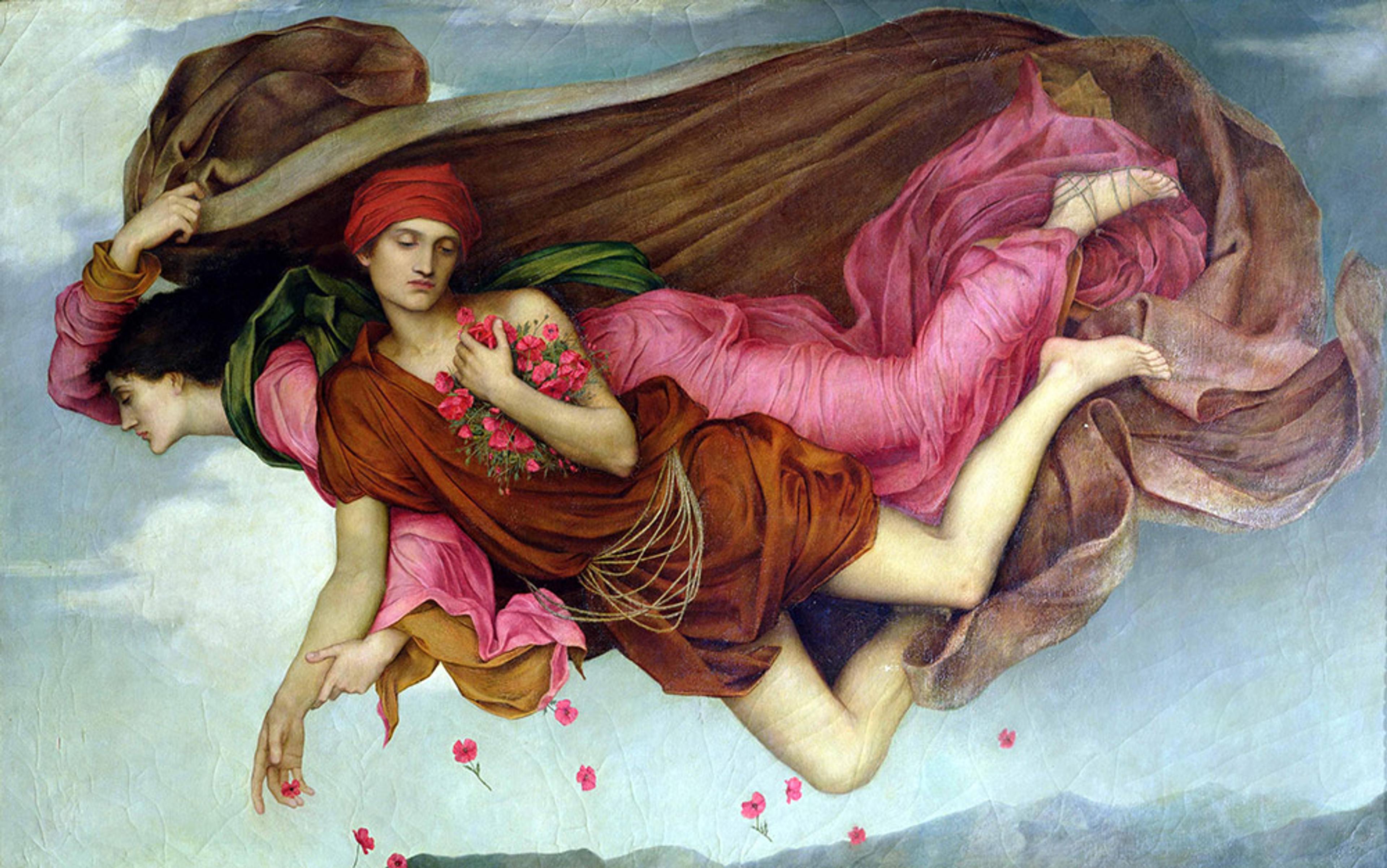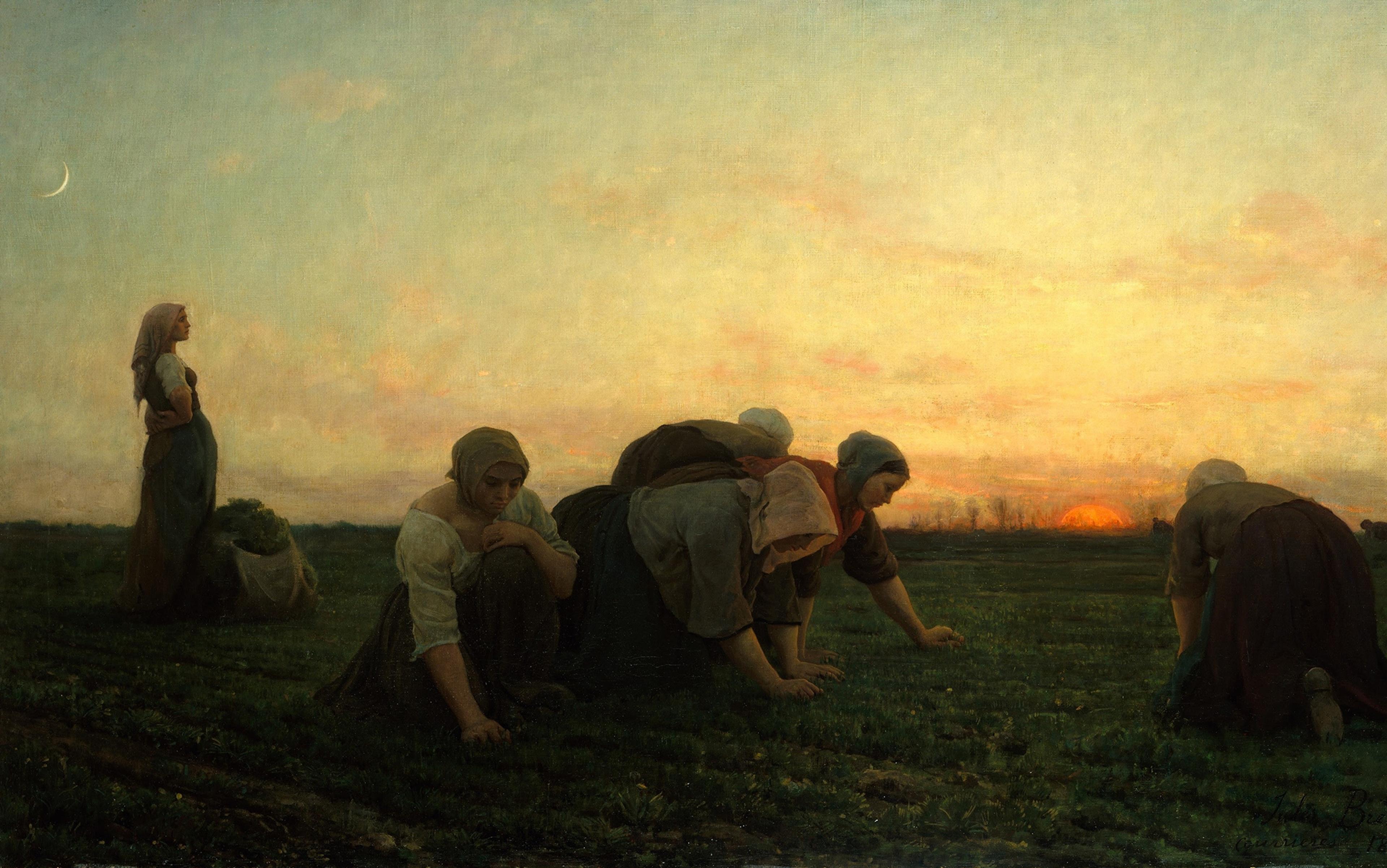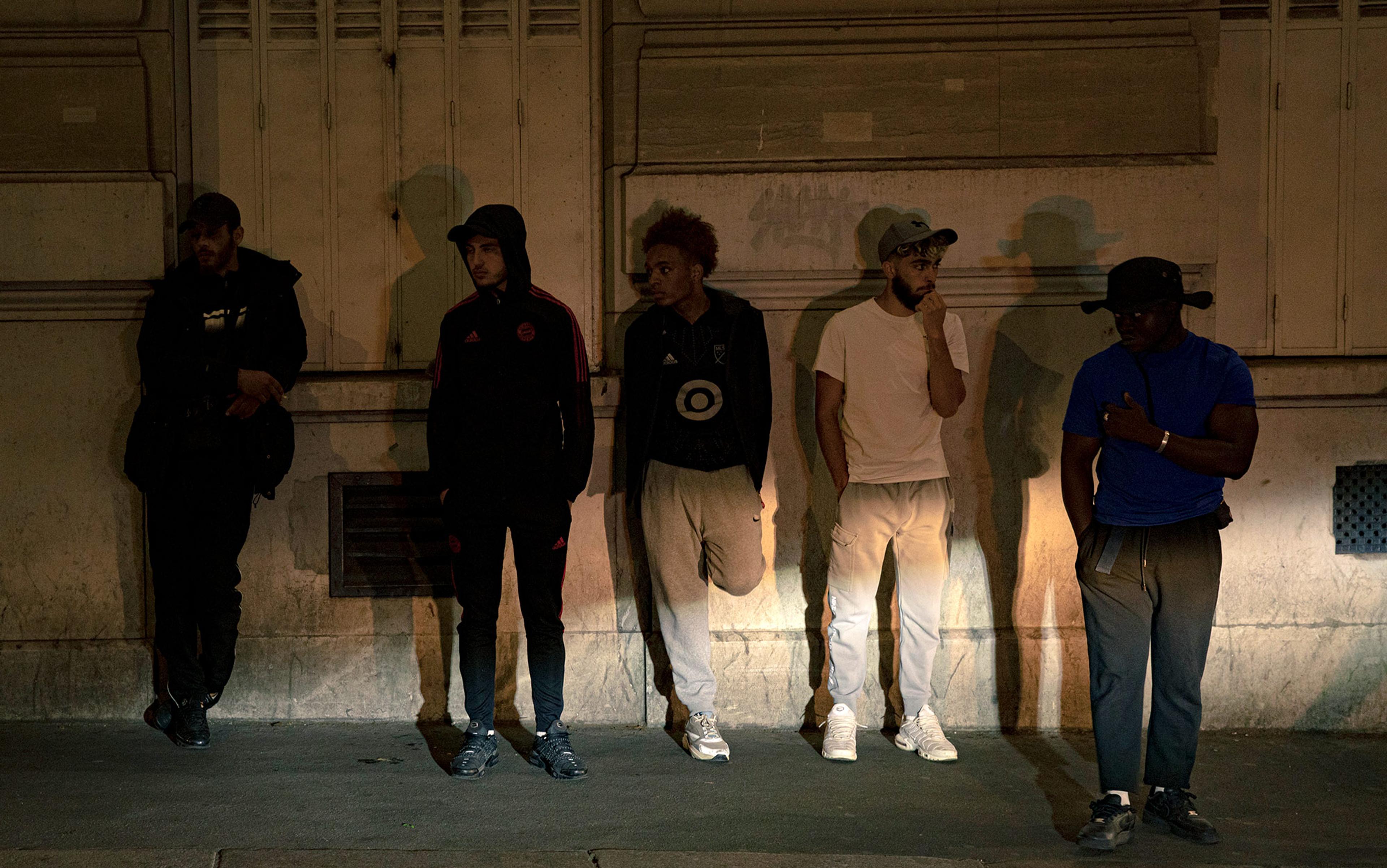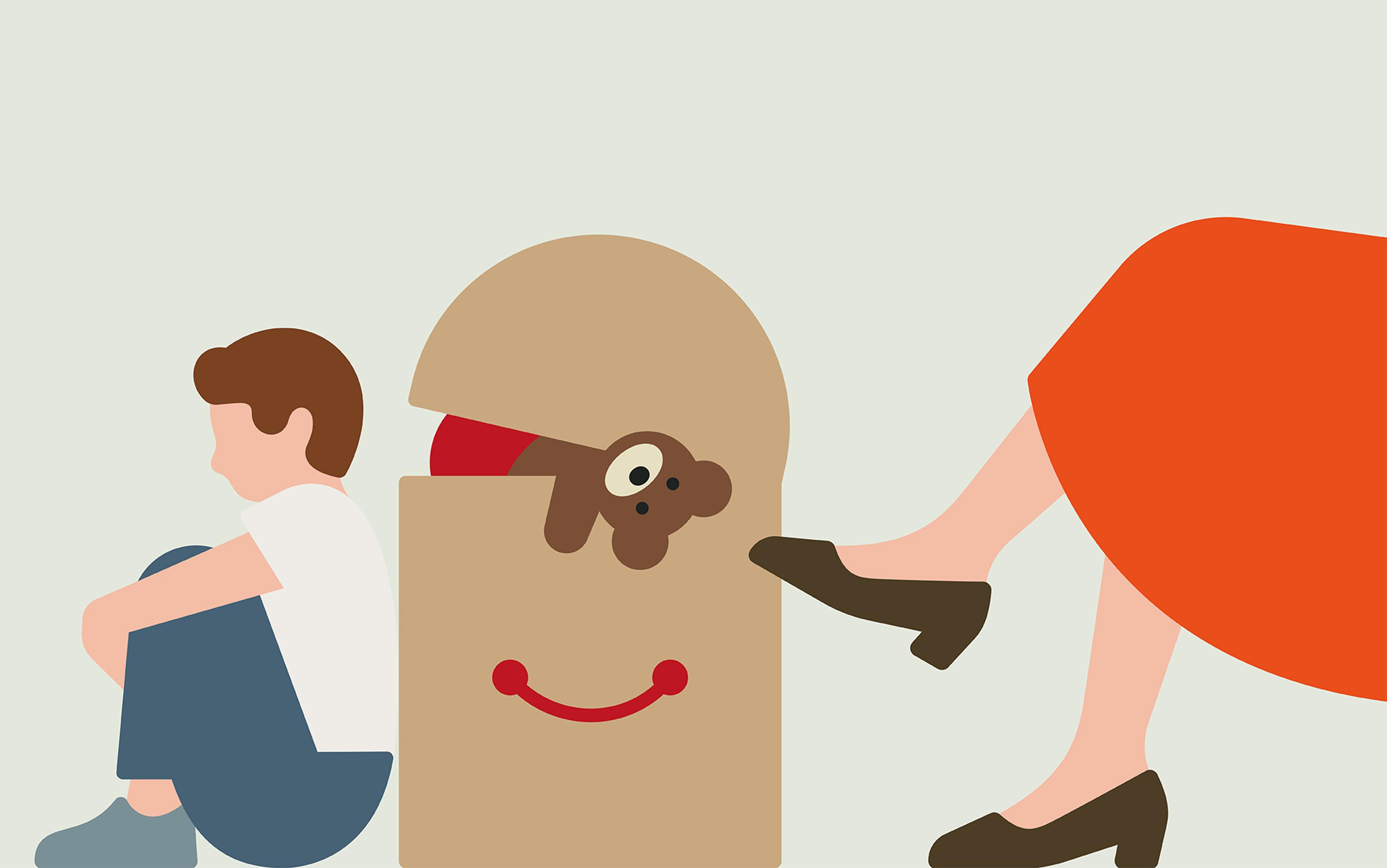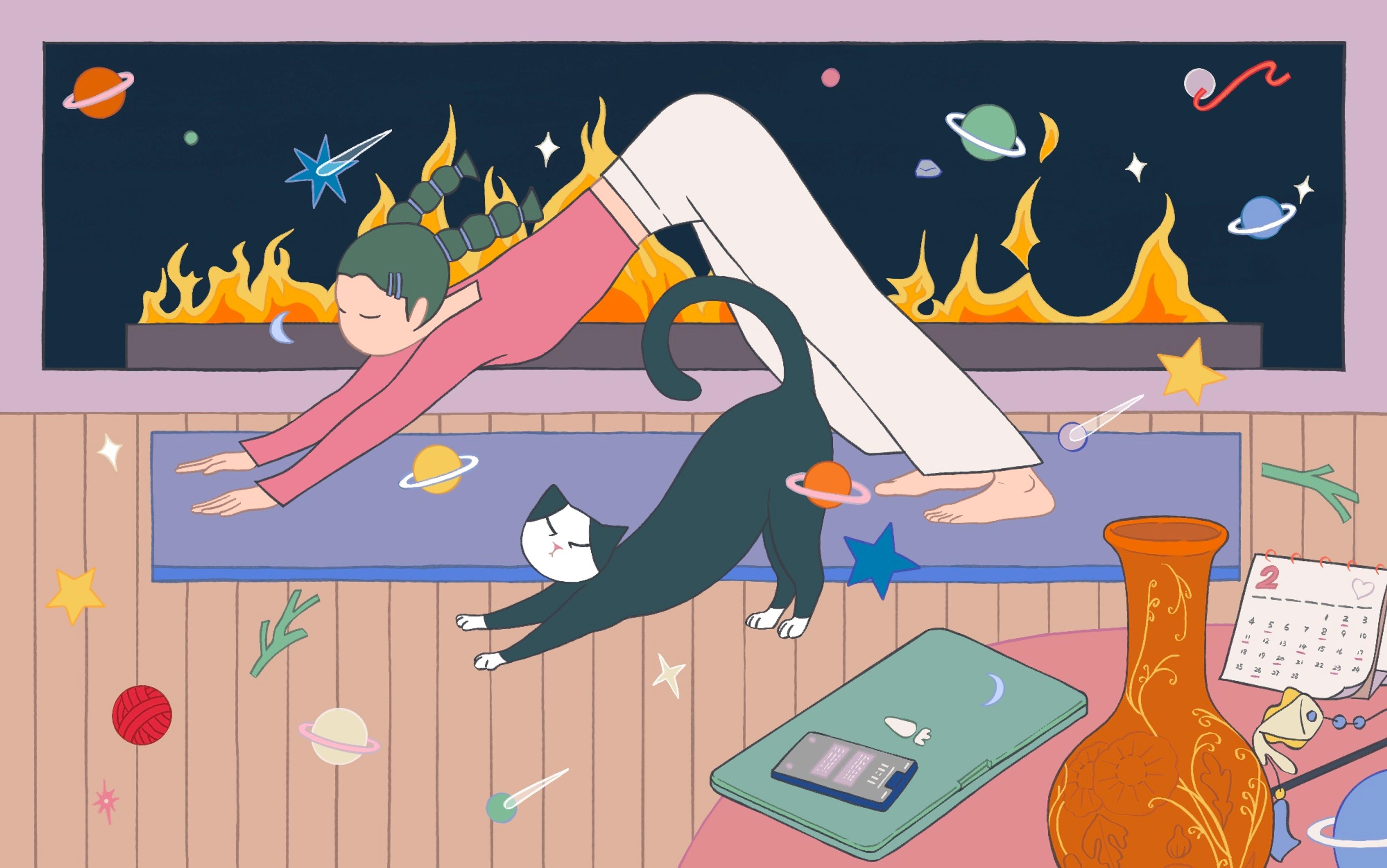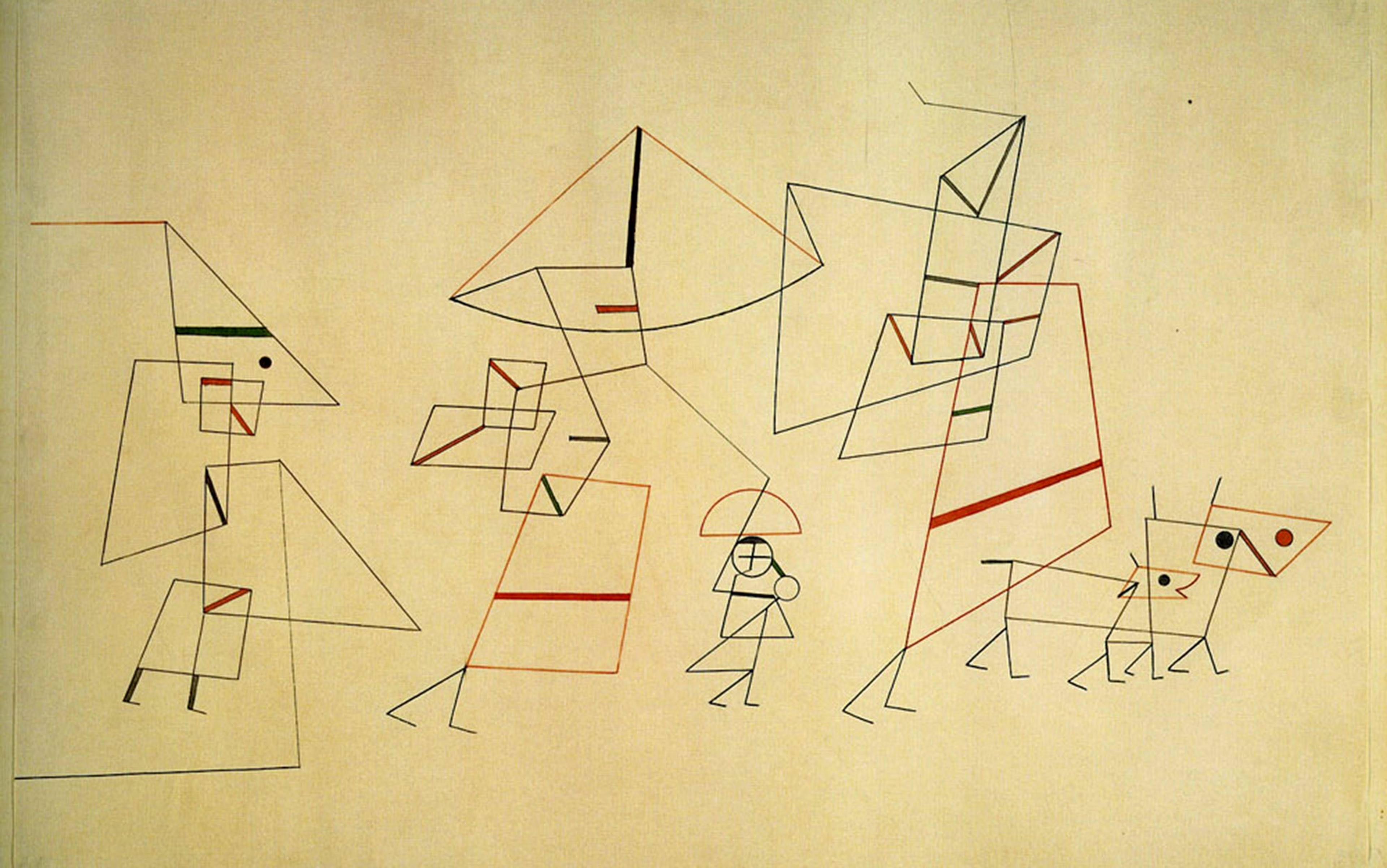In Evelyn De Morgan’s numinous painting, Night and Sleep (1878), Nyx, the mighty Greek goddess of night, hovers across a dusky sky with her beloved son Hypnos, the sweet-natured god of sleep. The painting and the Greek gods it captures depict a radically different way of understanding and relating to sleep. In antiquity sleep was personified, transcendent, even romantic.
Both Nyx and Hypnos had personality. Nyx was beautiful, shadowy and formidable – the only goddess Zeus ever feared. A Mother Nature figure with attitude, she was most protective of her son, even when he engaged in divine mischief. Which he did. But Hypnos was also gentle and benevolent, an androgynous mamma’s boy. Occupying a liminal zone between sleep and waking, he often seemed a bit dreamy. If he showed up at a sleep clinic today, he would likely be diagnosed with narcolepsy – a disorder of heightened permeability in the boundary between waking and sleep.
Nyx and Hypnos were denizens of the underworld. She was the original night owl, a fierce guardian of nature’s circadian rhythms who magically transformed day into night. With her support, as seen in De Morgan’s painting, Hypnos gently scatters crimson poppies, sleep elixirs, over the planet below. As in the more recent tale of the Sandman who sprinkles sleepy dust over the eyes of children, we are reminded that sleep is bequeathed from above. That sleep is grace.
Nyx and Hypnos were a dynamic duo of sorts – supernatural heroes who romanticised night and sleep. Nyx gave birth to sleep and created an aesthetic of darkness where Hypnos could flourish. And Hypnos loved sleep. Surrounded by fields of wild poppies on the River of Oblivion, his lair was a sanctuary – a cool, magical retreat open to all in celebration of the sensual, even sexy, mysteries of sleep.
Today, mother and son have been largely forgotten. Nyx has been in exile for well over a century as our night sky is eroded by light pollution. And Hypnos is remembered mainly by his namesakes, hypnosis and, surely to his chagrin, hypnotics. Sleep is no longer personal, transcendent and romantic – it is medical, mundane and pragmatic.
Sleep has been transformed from a deeply personal experience to a physiological process; from the mythical to the medical; and from the romantic to the marketable. Our misconstrued sense of sleep and consequent obsession with managing it are the most critical overlooked factors in the contemporary epidemic of sleep loss.
Something is very wrong. Despite decades of innovative sleep research, escalating numbers of new sleep specialists and clinics, and an explosion of media attention and public health education initiatives, the epidemic of insufficient sleep and insomnia appears to be getting worse.
In any given year, 30 per cent of adults report at least one symptom of insomnia, including trouble falling asleep, staying asleep or obtaining restorative sleep. The first decade of this century saw striking increases in the prevalence of insomnia, its associated daytime impairment, and use of sleeping pills. During this period, the diagnosis of sleep disorders jumped by 266 per cent and the number of prescriptions for sleep medication spiked by 293 per cent.
Many millions more suffer from chronic patterns of insufficient sleep resulting from the untenable expectations of modern life. In 1998, the National Sleep Foundation reported that 12 per cent of Americans slept less than six hours a night. By 2005, that number had jumped to 16 per cent.
The deleterious impact of chronic sleep loss on daily life is no longer news. Poor sleep significantly compromises our productivity and safety. And it seriously undermines our physical and mental health by triggering chronic inflammation in the brain and body. Chronic inflammation is a risk factor for cardiovascular disease, neurodegenerative disorders, autoimmune illnesses, diabetes, obesity, cancer and depression.
People with insomnia also suffer immensely by night. Beyond obvious frustrations around their thwarted efforts, and growing anxieties about the consequences of ongoing poor sleep, many also experience loneliness, shame and hopelessness. Although these feelings are suppressed in the light of day, they linger beneath the surface, eroding quality of life and dramatically increasing the risk for depression and even suicide.
The Industrial Revolution radically transformed our perception of sleep from a gracious, transcendent experience to a mechanistic, biomedical process. With mechanistic philosophies on the rise, the machine emerged as a new hero, with its promise of salvation from all human ills. And energy became gold.
Across the Western world, machines and labourers sprouted in concert with coal mines and coffee houses. Industrialisation seeded a global energy crisis – serving as metaphor for our personal energy crisis. Today, oil and coffee are the most commonly traded commodities in the world. We are a society of energy addicts dependent on overly stimulating foods, fluids, information, entertainment and light at night. And, of course on the extensive global network of machinery needed to manufacture and maintain this lifestyle.
We can no longer deny the striking parallel between global warming and chronic inflammation. Ultimately, our excessive consumption of energy overheats the planet and its people, both of which need to cool at night to sleep. Chronic inflammation can literally raise our core body temperature to a near-feverish point, overheating our brains and bodies and disrupting our sleep.
Industrialisation encroached on night and sleep. While the skies of antiquity were populated with a wild pantheon of gods and goddesses, the heavens today are crowded with flying machines, including tens of thousands of aircraft and satellites. Unable to tolerate light-polluted environments, Nyx remains in exile. And without his mother, Hypnos languishes. During the height of industrialisation, sleep was debased as an enemy of civilisation. Thomas Edison led a popular charge to dominate and even eliminate sleep.
Like a wild thing, sleep was lured from its home in nature, and domesticated in service of industrial life. And today, like a pet, sleep is fenced in, caged or corralled. We constrict sleep with delayed bedtimes and advanced rising times policed by a mechanistic alarm clock. Would we consider setting an alarm to truncate other natural human experiences? Imagine setting an alarm to limit time spent enjoying a meal or making love.
In more recent decades, the domestication of sleep has given way to its medicalisation. Hypnos has been abducted and is being held captive in research labs, clinics and pharmacies. The field of sleep medicine has encouraged us to think of sleep as a complex biomedical process that lies outside of our awareness – a perspective that impedes our personal relationship with sleep.
Medicalisation obscures the subjective experience of sleep with objective metrics. Today, we talk about our sleep as we do other health issues, using the language of numbers. We’re concerned with time spent in various sleep stages, sleep efficiency and, of course, our total sleep time. The most common question I’m asked as a sleep and dream specialist is: ‘How much sleep do I need?’ Sleep length is considered the definitive measure of sleep. But this is like asking: ‘How many calories should I eat?’ Of course, the answer to both questions is: ‘It depends.’
In reality, sleeping pills produce a kind of counterfeit slumber by inducing amnesia for nighttime wakefulness
Numbers are distracting. Just as the name is not the thing, neither is the number. Sleep metrics are useful, but they are only measures of physiological activity correlated with sleep. They are not measures of actual sleep.
Medicalisation reduces sleep to just another health regimen, so we attempt to manage it the way we do exercise, stress and diet. We compulsively tweak our sleep with an endless stream of expert tips from countless books, articles and blogs. When these patchwork fixes fail, which they inevitably do, we are vulnerable to the seduction of direct-to-consumer advertising for sleeping pills.
Medicalisation encourages the use of ineffective and dangerous drugs. In reality, sleeping pills produce a kind of counterfeit slumber by inducing amnesia for nighttime wakefulness. They do not heal insomnia; they suppress its symptoms. Ongoing reliance on sleeping pills undermines our sleep self-efficacy, or trust in our innate ability to sleep. It also results in dependence or addiction, and significantly increases the risk of serious illness and death.
This is not to suggest we should never take anything to sleep. Hypnos was clearly fond of poppies. He kept a stash of them on hand and used them to invoke sleep. The essential mistake of medicalisation is using drugs or medical tips to replace sleep. In the long run, tweaking our sleep with tablets or tips doesn’t work because it circumvents the need to willingly transcend our waking self.
When speaking to the public as well as to professional audiences about sleep, I usually open with the question: ‘What is sleep?’ The room goes silent for a few seconds and then echoes with tentative terms such as not wakefulness or unconsciousness or, for professionals, non-REM (REM, or rapid eye movement sleep, is the way that scientists recognise the dream phase). The point is, if we attempt to define sleep at all, it is by way of the negative – in terms of what it’s not. It’s not waking, not consciousness, not dreaming.
Press a sleep specialist to say more, and they’ll likely highlight the numerous benefits sleep bestows on our health, performance, appearance, productivity, creativity, mood and more. They’ll offer complex descriptions of what goes on in the body and mind during sleep in terms of brainwaves measured by electroencephalogram (EEG) and neurophysiology.
But actual sleep can’t be reduced to squiggly EEG tracings and the nightly cascade of neurohumors. As important as an objective biomedical view of sleep might be, it is insufficient because it largely disregards the experience of the sleeper. It largely disregards sleep. The brain doesn’t sleep. Neither does the body. We do.
Great philosophers have taught that most of us mistake the limits of our own perception for the limits of the universe. Nowhere is this conundrum more relevant than in our contemporary take on sleep. We are mired in a pre-Copernican-like, wake-centric era regarding consciousness. We presume waking to be the centre of the universe of consciousness, and we relegate sleeping and dreaming to secondary, subservient positions.
Looking at sleep solely through waking-world eyes is like looking at a glorious night sky through dark sunglasses. We are caught in wakism, a subtle but pernicious addiction to ordinary waking consciousness that limits our understanding and experience of sleep.
Wakism underlies the medicalisation and domestication of sleep, reinforcing a dysrhythmic, relentless and speedy posture of hyperarousal. As John Lennon sang in ‘I’m So Tired’ (1968):
You know I can’t sleep, I can’t stop my brain.
You know it’s three weeks, I’m going insane.
You know I’d give you everything I’ve got
For a little peace of mind.
Hyperarousal is an inevitable consequence of our wakism. It refers to a turbocharged pace of life that is not modulated by adequate rest.
Strongly endorsed by popular culture, hyperarousal is a socially contagious condition rooted in an arrogant disregard for natural rhythms. It’s a cheap high, a kind of synthetic passion that is not without serious side effects.
From Icarus’s unchecked aspirations to Peter Pan’s resistance to landing, hyperarousal is clearly an archetypal human challenge
Characterised by racing brainwaves and a rapid heartrate, hyperarousal is linked to an overheated body and mind. By tethering us to the heights of waking, hyperarousal not only interferes with our nightly descent into sleep, it also masks our daytime sleepiness. Hyperarousal and insomnia both encourage drug and substance dependence. Caffeine, energy drinks and stimulant drugs help stoke perpetual flight, while alcohol, marijuana and sedating medications provide temporary, artificial respites.
From Icarus’s unchecked aspirations to Peter Pan’s resistance to landing, hyperarousal is clearly an archetypal human challenge. We are drawn to heights, to defy gravity, to fly with the gods. We’ve learned that it’s acceptable, even preferable to be up at night. And we just don’t want to slow, descend, and stop. We see glory in breaking free from the circadian dictates of Mother Nature.
Such adolescent defiance is emblematic of our rock ’n’ roll heroes. The Stones keep rolling, Aerosmith keeps soaring, and Jim Morrison made good on his pledge to never come down. Michael Jackson’s signature moonwalk and his Neverland estate are striking symbols of our wakism. Although attributed to an overdose of propofol, the actual cause of Jackson’s death was complications of hyperarousal. The epidemic of superstar deaths associated with desperate pharmaceutical measures to descend is sobering.
Hyperarousal leaves us sick and ‘t’wired’: simultaneously tired and wired. Being t’wired is the psychological equivalent of being on the rack. While wakism perpetually draws us upward, the gravity of our mounting sleepiness pulls us downward. We are uncomfortably stretched in opposite directions by equally potent forces. Not surprisingly, hyperarousal is linked to depression, which is characterised by a persistent sense of feeling stuck.
Is it possible that our more modern sense of the divine encourages hyperarousal? After all, the Judeo-Christian God rarely descends from his abode in the heavens and is known to have worked relentlessly for days on end before taking a day of rest. In sharp contrast, although capable of flight, the gods of antiquity were grounded. They lived on earth, atop a mountain, or like Nyx and Hypnos, underground. Although Nyx ascended nightly in devotion to her duty, she faithfully returned to her subterranean abode for daily rest.
Medicalisation obscures sleep’s true nature – its breadth and depth and joy. It conceals the personal, transcendent and romantic dimensions of sleep. We are in dire need of restoring our sense of sleep’s mythic dimensions – of reimagining our personal experience of sleep. I believe this can be best accomplished through poetry, spirituality and, ultimately, personal investigation.
From Rumi, who wrote ‘Every human being streams at night into the loving nowhere’, to Mary Oliver, who described sleep as a ‘luminous doom’, countless poets throughout the ages have explored the experiential and romantic mysteries of sleep. Sacred texts from Hindu, Buddhist, Jewish, Muslim, Christian and other traditions view sleep as a transcendent experience. Likewise, the works of spiritual pioneers such as Rudolf Steiner, Sri Aurobindo and Ken Wilber also emphasise the transcendent nature of sleep.
Contemporary medical views presume that there’s nothing in the world of sleep worth personally investigating. Sleep itself is believed to lie outside of our potential for awareness. And though we can be aware of dreams, they are too often deemed meaningless. Dismissing the value of dreams shuts the door on our most accessible, direct experience of sleep. It also dampens the sensual dimensions of sleep, which are most evident in dreams. In fact, whether aware of it or not, we routinely become sexually aroused in our dream sleep.
Mythic perspectives suggest that there is something in the deep waters of sleep worth accessing, and invite us to personally investigate it. Metaphorically, they encourage us to practise our descent into the waters of sleep with our third eye open.
From a mythic perspective, deep sleep is a state of profound serenity. But we commonly fail to notice it due to our pervasive wakism. We presume awareness of deep sleep is impossible because we have no waking reference points to conceptualise, name or recall it. But emerging research in yoga nidra, which focuses on sustaining awareness into deep states of relaxation and sleep, confirm what spiritual texts have suggested for centuries: that awareness of deep sleep is, in fact, attainable. Like other mythic approaches, the Advaita Vedanta, a school of Hindu philosophy, views deep, dreamless sleep as the highest state of awareness – a return to our default consciousness, our deepest Self.
Sleep loss, then, is not simply a medical problem; it is also a critical spiritual challenge. Our epic struggles with accessing deep sleep are, fundamentally, struggles with accessing deeper aspects of ourselves. As wakists, we presume that who we are is limited to our waking-world identity. Essential parts of who we are, however, are obscured by the glare of waking life. And these become more visible at night – in the deep waters of sleep and dreams.
Humility is the essential missing ingredient in our failed efforts at healing the insomnia epidemic
Deep, natural sleep threatens our wake-centric self. It makes sense that Thanatos, the Greek god of death, is the brother of Hypnos. An uneasy, archetypal relationship between sleep and death is, in fact, common in many cultures around the world. The Dalai Lama teaches that the psychospiritual experience of falling asleep is identical to that of dying. Our familiar, waking self dies in sleep. Opening to an ongoing dialogue with Hypnos – cultivating deepening awareness of sleep – teaches us that our ordinary waking self is but a limited sense of our deeper sleeping self.
The trajectory with which we approach sleep – how we dive into bed – will impact the depth of our descent. Surrendering our waking sense of self calls for a posture of humility. Humility is the antidote to hyperarousal. It counters the arrogance that informs our medicalisation and wake-centrism. Humility is the essential missing ingredient in our failed efforts at healing the insomnia epidemic.
Like an airplane in gradual descent from flight above the weather, coming down from hyperarousal involves negotiating a layer of turbulence. The body might vibrate, bounce and shake as the mind experiences updrafts of anxieties, of unresolved emotions and thoughts. Our challenge is to avoid reflexively re-ascending to escape this experience. Humility is about trusting that the safety of sleep resides just beyond the turbulence.
In contrast to crashing, dropping into sleep from sheer exhaustion or knocking ourselves out with drugs or alcohol, humility is about a conscious and intentional submission to sleep, to the care of Hypnos. It’s about intentionally putting our body to bed and then willingly losing our mind – releasing our waking sense of self.
Getting the body down can be challenging. Too often it’s been subjugated to the will of the mind, rode hard and put down wet. And hot. Keeping the body from overheating requires an anti-inflammatory lifestyle – good nutrition, regular exercise and effective stress management. A warm bath, gentle yoga and lower bedroom temperature can also help cool the body before bed.
The intelligent use of melatonin, one of the most popular supplements around the globe, can help, as well. Not a medication, but a natural neurohormone, melatonin is Nyx in a bottle. Like Nyx, melatonin emerges at night, cools us down, and encourages sleep and dreams. The same excessive light at night that drove Nyx into exile suppresses melatonin production in the body, resulting in the need for supplementation.
To descend and land, an aircraft must cooperate with gravity. Likewise, we can enlist gravity’s assistance in our descent to sleep. In contrast to the popular trend of sleeping under ever lighter, feathery comforters, many of us would benefit from using a weighted blanket, which essentially amplifies the effects of gravity. Weighted blankets provide a kind of adult swaddling that helps counter hyperarousal. It’s not about sleeping on a cloud. It’s about sleeping like a stone.
The body must be grounded to sleep well. ‘I thought the earth remembered me,’ wrote Oliver in ‘Sleeping in the Forest’ (1979), ‘she took me back so tenderly…’ The word bed is, in fact, derived from garden bed. We replant the body in bed, temporarily returning it to its origins for nourishment. ‘I slept as never before,’ Oliver continues, ‘a stone on the riverbed.’
In contrast with cats, who prefer to ascend to sleep, dogs literally get down. Considered the archetype of humility, dogs instinctively spiral over a spot on the ground in preparation for sleep. Their ready willingness to descend makes them poster pups for breaking the momentum of hyperarousal with humility.
Sleep is the great equaliser. We are all the same height in bed.
To fall asleep naturally, as opposed to just crashing into sleep when our wings melt, or knocking ourselves out with alcohol or drugs, we must be willing to do two things. We need to lose our mind – to surrender our waking sense of self. And we need to invoke sleep.
As the body settles into bed, our challenge is to let go of our ordinary mind, our waking sense of self. This part of us, the part of us we usually call I, is simply incapable of sleeping. It can walk us to the shoreline of the sea of sleep, but it can’t swim.
By definition, the part of us we call I can do only waking. Because wakism holds that this I is all that there is to us, it reinforces our addiction to waking and our reluctance to fall asleep. ‘I cannot sleep’, the universal slogan of insomnia, is inherently valid. Believing that the waking self needs to learn to sleep is a set-up.
Cognitive behavioural therapy for insomnia, a branch of sleep medicine that has focused on psychological alternatives to medications, has made significant contributions to the management of insomnia. It has devised and researched useful interventions such as sleep hygiene, stimulus control and challenging sleep misconceptions, but these are limited by a failure to recognise that we cannot teach the waking self to sleep. In the end, falling asleep is more an art than a science.
From the perspective of our waking self, falling asleep is an accident. We can only slip, slide or trip into it. Taking on falling asleep as a problem is the ultimate trap. We cannot intentionally cause an accident, which is what the waking self persistently tries to do. Letting go of the waking self is an act of humility.
In doing so, we open more to thinking of something outside of our self – to inviting sleep.
Governed by powerful divine forces, sleep in antiquity was achieved by invoking the gods. Invocation is about opening to a benevolent mystery, requesting divine assistance or calling to a higher power through meditation, prayer or sacred ritual.
We need to approach sleep as a practical matter without losing sight of it as a personal, intimate relationship
It’s about opening a respectful dialogue with sleep. Whether coming from another or oneself, that most common nightly dictate ‘Go to sleep’ is a demand. By contrast, invoking sleep is about a gentler, more compassionate conversation. It’s an invitation, as if from a lover or Hypnos himself, to ‘Come to sleep’.
Invoking sleep helps us fall in love with the act.
Although they might appear antithetical, medical and mythical perspectives of sleep must be integrated if we are to effectively address our epidemic of sleeplessness. Tweaking our sleep with expert medical advice requires that we simultaneously transform our sense of sleep with age-old mythic wisdom. We need to approach sleep as a practical matter without losing sight of it as a personal, intimate relationship.
Hypnos graciously dispensed sleep. It was not a prize to be won or a commodity to be purchased. It was not something we had to work for, but something we had to be willing to stop working for. Sleep was offered as a gift – as an act of love.
After completing talks on sleeplessness, I am often approached by audience members with personal questions or comments. At times, someone intentionally falls to the back of the line and waits for privacy. They might glance about to make sure no one is within earshot before they lean in and whisper: ‘I love sleep! … I mean I really love sleep!’ Maybe they don’t want to offend all the sleepy heads in the room. Or, maybe they feel vulnerable sharing something so very dear to them.
Their love of sleep is not rooted in the desperation of chronic sleeplessness. Quite the opposite. It’s about a heartfelt devotion to an intimate relationship with sleep, a nightly romantic encounter with Hypnos. Approaching sleep mindfully, with our third eye open, is risky. Opening to receiving it as a gift leaves us vulnerable to falling in love with sleep.
